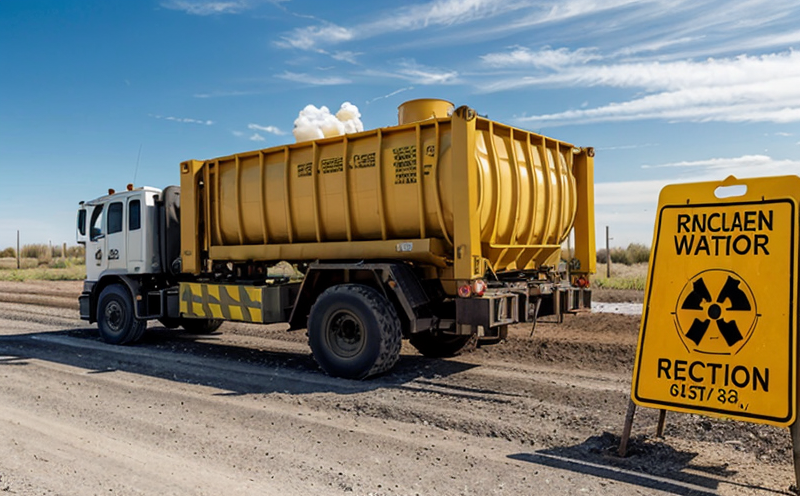ASTM C1308 Accelerated Leach Test for Waste Forms
The ASTM C1308 standard provides a method to evaluate the leaching characteristics of waste forms under accelerated conditions. This test is particularly important in the context of radioactive and nuclear waste management, where understanding how materials interact with their environment over time can significantly influence safety and regulatory compliance.
Leaching refers to the process by which soluble components are dissolved from a solid matrix into a liquid medium. For radioactive waste forms, it is crucial to assess these processes early in the lifecycle of the waste form to ensure long-term stability and prevent unintended release of harmful materials into the environment.
The ASTM C1308 test method involves placing a specified amount of waste material into a leaching solution under controlled conditions. The leachate (the liquid that has been in contact with the waste) is then analyzed for various parameters, including pH, conductivity, and concentrations of specific elements or compounds.
The accelerated nature of this testing allows researchers to simulate decades of natural aging within days or weeks. This capability is essential for optimizing waste form designs and ensuring regulatory compliance without waiting years for real-world results.
One key aspect of the ASTM C1308 test is the use of a leachate solution that mimics environmental conditions. For radioactive waste, this often includes simulating water with varying pH levels and ionic strengths to reflect potential groundwater or surface water environments. The choice of solution can significantly influence the results, highlighting the importance of accurate specimen preparation.
Specimen preparation is critical in ASTM C1308 testing. Waste forms are typically cut into uniform cubes of a specified size before being placed in the leaching vessel. The dimensions and orientation of these specimens can impact the rate and extent of leaching, emphasizing the need for precise handling and preparation.
The instrumentation used in this test is designed to ensure accurate measurement of both the leachate and the waste form during the testing period. This includes pH meters, conductivity meters, and specialized sampling devices capable of extracting leachate without disturbing the waste form.
Reporting from ASTM C1308 tests provides a comprehensive overview of the leaching characteristics of the tested waste forms. Reports typically include detailed data on leachate composition over time, along with comparisons to accepted limits or standards set by regulatory bodies such as the International Atomic Energy Agency (IAEA).
The results of these tests are invaluable for R&D engineers and quality managers in developing more robust waste management solutions. By identifying potential issues early in the design process, they can implement necessary adjustments before full-scale implementation.
Understanding the implications of ASTM C1308 testing is essential for compliance officers as well, who ensure that all operations adhere to international standards like ISO 14971 and IEC 62304. This ensures not only regulatory compliance but also public safety and environmental protection.
The test method itself has evolved over time, with ongoing research aimed at refining the parameters used in leachate simulation and specimen preparation. These refinements are crucial for maintaining relevance and accuracy as new materials and technologies emerge in waste management.
Applied Standards
| Standard Number | Description |
|---|---|
| ASTM C1308-17 | Standard Practice for Accelerated Leach Test of Waste Forms by Simulating Site-Specific Conditions. |
| ISO 15962:2014 | Determination of leaching from waste forms and containers. |
The ASTM C1308-17 standard provides a comprehensive framework for simulating site-specific conditions, allowing for more accurate prediction of real-world performance. This is particularly important in the context of radioactive waste management, where the environment can vary significantly depending on the location and type of waste.
ISO 15962:2014 offers additional insights into leaching from waste forms and containers, complementing the ASTM C1308 method. Together, these standards provide a robust foundation for evaluating the performance of various waste forms under accelerated conditions.
Eurolab Advantages
At Eurolab, we bring extensive experience in waste management testing to every project. Our team of experts ensures that all ASTM C1308 tests are conducted with precision and accuracy, delivering reliable results that can be trusted by regulatory bodies.
We provide state-of-the-art facilities equipped with the latest instrumentation for measuring leachate composition. This includes advanced pH meters, conductivity meters, and specialized sampling devices capable of extracting leachate without disturbing the waste form.
Our quality management systems are ISO 9001:2015 certified, ensuring that every step of the testing process adheres to international best practices. This guarantees that our results are not only accurate but also reliable and repeatable.
We offer a full range of services tailored to meet the specific needs of our clients in the waste management sector. From specimen preparation to final analysis, we ensure that each test is conducted according to the highest standards.
Our experienced team of engineers and scientists has extensive experience in this field, providing valuable insights into the implications of ASTM C1308 testing for your specific project needs.
International Acceptance and Recognition
- The ASTM C1308 standard is widely accepted in the nuclear waste sector for its ability to simulate long-term leaching processes under accelerated conditions.
- It is recognized by regulatory bodies such as the International Atomic Energy Agency (IAEA) and the Nuclear Regulatory Commission (NRC).
The ASTM C1308 Accelerated Leach Test has earned international recognition for its ability to provide reliable data on waste form performance. This recognition underscores its importance in ensuring both safety and regulatory compliance.





